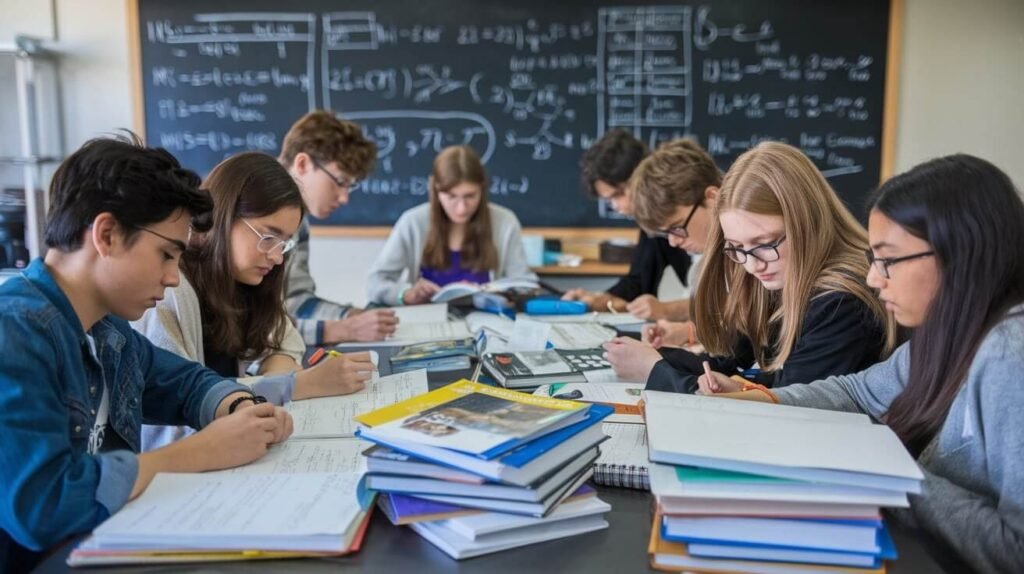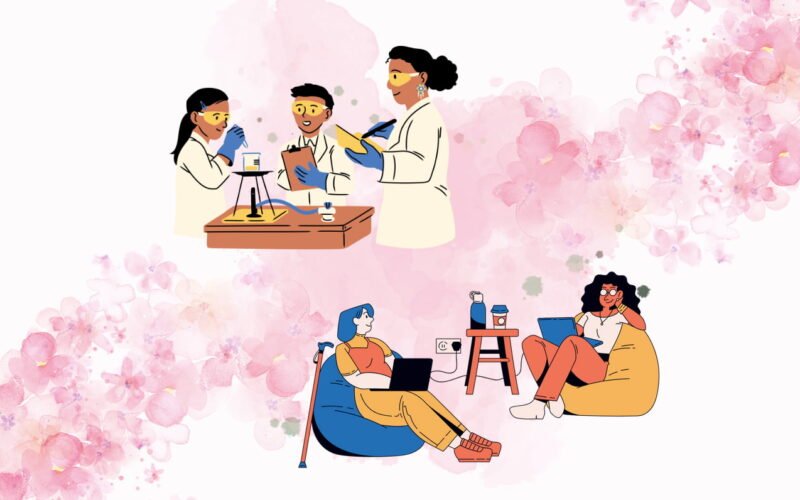How Teenagers Are Breaking into Scientific Publishing
In an era where scientific advancements shape our world, a remarkable phenomenon is emerging – teenagers are setting their sights on the lofty goal of becoming co-authors of scientific papers.
Table Of Content
- How Teenagers Are Breaking into Scientific Publishing
- Including High School Students as Co-Authors: Is It Possible?
- Navigating the World of Academic Authorship for Teens
- Challenges Faced by Young Researchers
- Inspiring Success Stories of Teenage Researchers
- Mentorship: A Key to Unlocking Teen Scientific Potential
- Ethical Concerns in Youth Research Participation
- Fostering a Supportive Environment
- Diversity and Inclusion
- Future Implications
- Conclusion
This pursuit, once considered the exclusive domain of seasoned researchers and academics, is now capturing the imagination of high school students driven by an insatiable curiosity and a burning desire to contribute to the frontiers of knowledge.
These young minds are defying conventional expectations, fueled by an innate thirst for exploration and a relentless pursuit of understanding.
Their ambition is not merely a fleeting fancy but a deeply rooted passion that transcends the confines of traditional education. They seek to push boundaries, challenge established norms, and leave an indelible mark on the scientific landscape.
Undeterred by the complexities of research and the rigor of academic publishing, these teenagers approach their goals with a refreshing blend of enthusiasm and determination.
They are willing to invest countless hours in laboratories, poring over journals, and engaging in intellectual discourse with mentors and peers alike.
Their hunger for knowledge is insatiable, and their commitment to scientific inquiry is unwavering.
What sets these young scholars apart is their ability to see beyond the limitations imposed by age and experience. They possess an unparalleled sense of wonder, a willingness to ask questions that others might overlook, and a fearlessness in challenging conventional wisdom.
Their perspectives, unencumbered by preconceived notions, offer the potential for groundbreaking insights and innovative solutions to longstanding problems. In sum, The reasons teenagers are drawn to scientific publishing:
- Passion for learning and discovery.
- Desire to contribute to real-world solutions.
- Early exposure to scientific methodologies.

Including High School Students as Co-Authors: Is It Possible?
Engaging in scientific research during the teenage years can be an invaluable experience that offers numerous benefits for personal and academic growth.
One of the primary advantages is the opportunity to develop critical thinking and problem-solving skills at an early age.
By grappling with complex research questions and exploring various methodologies, teenagers can cultivate analytical abilities that will serve them well throughout their academic and professional careers.
Furthermore, early exposure to research allows young minds to gain a deeper understanding of scientific methodologies and processes.
They learn firsthand about formulating hypotheses, designing experiments, collecting and analyzing data, and drawing conclusions based on empirical evidence. This hands-on experience not only reinforces theoretical concepts but also instills a greater appreciation for the rigor and discipline required in scientific inquiry.
| Pros | Cons |
| Develops critical thinking | Potential lack of experience |
| Encourages early career interest | Requires significant guidance |
| Enhances college applications | May face skepticism from peers |
Navigating the World of Academic Authorship for Teens
Participating in research projects also fosters creativity and innovation.
As teenagers tackle novel problems and seek to contribute new knowledge, they are encouraged to think outside the box and explore unconventional approaches. This mindset can be invaluable in driving scientific progress and paving the way for future breakthroughs.
Moreover, engaging in research at a young age can help teenagers develop a passion for science and solidify their interest in pursuing STEM (Science, Technology, Engineering, and Mathematics) fields.
List steps or tips for teens to navigate authorship:
- Find a mentor with research experience.
- Engage in science clubs or online forums.
- Start with smaller projects or assist in ongoing research.
Challenges Faced by Young Researchers
Embarking on the journey of co-authoring scientific papers as a high school student is a laudable pursuit, yet it is paved with significant challenges and obstacles.
These driven individuals often find themselves navigating uncharted territories, confronting limited resources, grappling with a lack of mentorship, and facing potential skepticism from the established scientific community.
One of the primary hurdles lies in accessing the necessary resources and equipment required for conducting rigorous scientific research.
High schools, despite their best efforts, may lack the cutting-edge facilities and technologies found in universities and research institutions. This resource gap can hinder students’ ability to execute complex experiments, analyze data effectively, or explore advanced methodologies.

Moreover, the absence of dedicated mentorship can prove to be a formidable obstacle. Experienced researchers play a crucial role in guiding young minds, imparting invaluable knowledge, and providing constructive feedback throughout the research process.
Without such guidance, high school students may find themselves grappling with conceptual complexities, experimental design flaws, or analytical pitfalls that could undermine their efforts.
Furthermore, the scientific community itself may harbor skepticism towards the involvement of high school students in co-authoring research papers.
This skepticism can stem from concerns about the depth of understanding, methodological rigor, or the ability to contribute meaningfully to the scientific discourse. Overcoming such preconceptions and gaining credibility can be a daunting task for these ambitious young scholars.
Despite these challenges, the determination and passion of high school students seeking co-authorship should not be underestimated.
With the right support systems, access to resources, and a nurturing environment that fosters curiosity and critical thinking, these obstacles can be navigated, and the path to scientific excellence can be paved.
Inspiring Success Stories of Teenage Researchers
In recent years, several remarkable high school students have defied expectations and made significant contributions to the scientific community by co-authoring papers alongside experienced researchers.
Their stories serve as inspiring examples of how youthful curiosity, dedication, and passion can transcend age barriers and advance the frontiers of knowledge.
One such trailblazer is Kavya Kopparapu, a young woman from Virginia who, at the age of 16, co-authored a research paper on exoplanet detection methods.
Her work, published in the prestigious Astrophysical Journal, garnered international attention and earned her recognition from prestigious organizations like NASA and the Harvard-Smithsonian Center for Astrophysics.
Another notable case is that of Indrani Das, a high school student from New Jersey who, at the tender age of 17, became the youngest researcher to have a first-author paper published in the prestigious journal Science.
Her groundbreaking work on nanotechnology and its potential applications in treating brain cancer opened up new avenues for exploration and demonstrated the profound impact that young minds can have on scientific progress.
Closer to home, the story of Jack Andraka, a Maryland native, is equally inspiring. At just 15 years old, Andraka developed a revolutionary method for detecting pancreatic cancer at an early stage, a breakthrough that could potentially save countless lives.
His work earned him numerous accolades, including the prestigious Gordon E. Moore Award and a feature in the Smithsonian Museum of American History.
These remarkable individuals not only showcase the immense potential of young minds but also highlight the importance of providing opportunities and support for budding scientists.
Their achievements serve as a testament to the power of curiosity, perseverance, and the pursuit of knowledge, regardless of age or circumstance.
For example, the “Investigation of everyday locations for antibiotic-resistant bacteria in Cambridge, Massachusetts” or “Antibacterial activity and absorption of paper towels made from fruit peel extracts” exemplify how students can participate in meaningful research that addresses real-world problems. Additionally, “A simple printing solution to aid deficit reduction,” a study picked up by CNN and widely covered in national media, illustrates how young researchers’ work can make a broad societal impact.
Mentorship: A Key to Unlocking Teen Scientific Potential
Mentorship and guidance from experienced researchers, educators, and professionals are invaluable in supporting and nurturing young scientific talent.
Teenagers aspiring to co-author scientific papers often lack the necessary knowledge, skills, and resources to navigate the complex world of academic research.
Mentors play a crucial role in providing direction, feedback, and encouragement throughout the research process.
They can help teenagers identify relevant research topics, develop hypotheses, design experiments, and interpret data. Additionally, mentors can offer insights into academic writing, peer review processes, and publication strategies, ensuring that the work meets the rigorous standards of scientific journals.
Furthermore, mentors can serve as role models, inspiring teenagers to pursue careers in science and fostering a passion for lifelong learning.
By sharing their own experiences, challenges, and successes, mentors can help young researchers develop a growth mindset and resilience, essential qualities for thriving in the competitive world of academia.
Effective mentorship requires a collaborative and supportive relationship built on trust, respect, and open communication.
Mentors should create a safe and inclusive environment where teenagers feel empowered to ask questions, express their ideas, and learn from their mistakes. Regular meetings, constructive feedback, and goal-setting can help maintain focus and motivation throughout the research journey.
In addition to individual mentorship, teenagers can benefit from participating in research groups, workshops, or summer programs that provide structured guidance and opportunities for peer collaboration.
These platforms facilitate knowledge sharing, networking, and the development of essential soft skills, such as teamwork, communication, and problem-solving.
Ultimately, mentorship and guidance play a pivotal role in nurturing the next generation of scientific leaders.
The key roles mentors play in supporting young researchers:
- Providing expert guidance and feedback.
- Helping in the development of research skills.
- Offering networking opportunities within the scientific community.
Ethical Concerns in Youth Research Participation
The pursuit of scientific knowledge and discovery is a noble endeavor, but when it involves minors, ethical considerations must take precedence. As teenagers strive to become co-authors of scientific papers, it is imperative to ensure their rights and well-being are protected throughout the process.
Obtaining proper consent is a fundamental requirement. Both the teenagers and their legal guardians must be fully informed about the nature of the research, potential risks, and their roles and responsibilities.
This consent should be voluntary, without any coercion or undue influence, and should be an ongoing process, allowing for withdrawal at any time.
Additionally, measures must be in place to safeguard the privacy and confidentiality of the minors involved. Any personal information or data collected during the research should be handled with utmost care and in compliance with relevant laws and regulations.
Furthermore, the research activities should be designed and conducted in a manner that minimizes potential harm or distress to the participants. Psychological, emotional, and physical well-being should be prioritized, and appropriate support systems should be available if needed.
Ethical guidelines and protocols specific to research involving minors should be strictly adhered to. These guidelines may vary depending on the institution, field of study, and geographic location, but they generally aim to uphold the principles of respect, beneficence, and justice.
It is also crucial to ensure that the teenagers’ involvement in the research is not exploitative or coercive. Their contributions should be acknowledged and valued, and they should have a voice in the decision-making processes related to the research.
key ethical considerations in a concise list:
- Obtain proper consent from minors and guardians.
- Ensure privacy and confidentiality.
- Design research to minimize harm or distress.
Fostering a Supportive Environment
Encouraging and nurturing the scientific curiosity of teenagers is crucial for their intellectual growth and the advancement of knowledge.
By fostering a supportive environment, we can empower these young minds to explore their interests, develop critical thinking skills, and contribute to the scientific community.
One effective strategy is to organize science fairs and competitions within schools and local communities. These events provide a platform for students to showcase their research projects, exchange ideas, and receive valuable feedback from experts and peers. Not only do they promote scientific inquiry, but they also cultivate a sense of healthy competition and collaboration.
Additionally, offering internship opportunities in research laboratories or institutions can be a transformative experience for high school students.
Working alongside seasoned researchers, they can gain first-hand exposure to the scientific process, learn advanced techniques, and develop a deeper appreciation for the rigor and dedication required in scientific pursuits.
Mentorship programs are another valuable resource that can foster a supportive environment. By pairing students with experienced scientists or graduate students, they can receive guidance, advice, and encouragement throughout their research journey.
Mentors can help navigate the complexities of scientific writing, experimental design, and data analysis, while also serving as role models and sources of inspiration.
Furthermore, establishing partnerships between schools and universities or research organizations can create a seamless pipeline for students to transition into higher education and research careers.
These collaborations can facilitate access to resources, equipment, and expertise that may not be readily available in high school settings.
Ultimately, fostering a supportive environment requires a collective effort from educators, researchers, policymakers, and the broader community.

Diversity and Inclusion
Promoting diversity and inclusion in scientific research is crucial for fostering innovation, broadening perspectives, and ensuring that scientific endeavors reflect and serve the needs of our diverse society.
By encouraging participation from underrepresented groups and individuals with diverse backgrounds, we can tap into a wealth of unique experiences, viewpoints, and approaches that can enrich and advance scientific inquiry.
Traditionally, the scientific community has been dominated by a relatively homogeneous group, often excluding or marginalizing individuals from certain racial, ethnic, socioeconomic, or cultural backgrounds.
This lack of diversity not only perpetuates systemic inequalities but also limits the potential for groundbreaking discoveries and solutions that could benefit humanity as a whole.
When teenagers from diverse backgrounds are given the opportunity to engage in scientific research and co-author papers, it not only nurtures their intellectual curiosity and fosters a love for science but also exposes them to role models and mentors who can inspire and guide them.
This early exposure can have a profound impact on their academic and career trajectories, encouraging them to pursue STEM fields and contribute their unique perspectives to the scientific discourse.
By embracing diversity and inclusion, we can address long-standing biases and barriers that have historically hindered the participation of underrepresented groups in scientific research.
This includes actively recruiting and supporting students from diverse backgrounds, providing mentorship and resources, and creating an inclusive and welcoming environment where all voices are heard and valued.
Moreover, diverse teams bring a range of lived experiences, cultural backgrounds, and problem-solving approaches, which can lead to more robust and comprehensive research outcomes.
When individuals from different backgrounds collaborate, they can challenge conventional wisdom, ask novel questions, and offer fresh perspectives, ultimately driving scientific progress and innovation.
Fostering diversity and inclusion in scientific research is not only an ethical imperative but also a strategic imperative for advancing knowledge and addressing complex global challenges.
Future Implications
Nurturing a generation of young researchers who are exposed to scientific inquiry from an early age could have far-reaching implications for the future of research and innovation.
These teenagers are not only gaining invaluable experience and knowledge but also developing critical thinking skills, problem-solving abilities, and a passion for discovery that will serve them well throughout their academic and professional careers.
By encouraging and supporting teenagers to become co-authors of scientific papers, we are cultivating a pipeline of talented individuals who may go on to make groundbreaking contributions in their respective fields.
Their fresh perspectives and unique approaches to problem-solving could lead to innovative solutions and new avenues of exploration.
Moreover, this early exposure to the rigors of scientific research could inspire these young minds to pursue careers in STEM fields, addressing the ongoing need for a diverse and skilled workforce in these crucial areas.
Their involvement in scientific research from a young age could also foster a lifelong commitment to intellectual curiosity and a desire to push the boundaries of human knowledge.
As these teenagers grow into the researchers and scientists of tomorrow, they may bring a renewed sense of enthusiasm and creativity to their work, challenging long-held assumptions and driving progress in ways we cannot yet imagine.
Their early experiences could shape the future of research by promoting collaboration, interdisciplinary approaches, and a willingness to take risks in pursuit of groundbreaking discoveries.
Ultimately, nurturing a generation of young researchers could lead to a more diverse, innovative, and dynamic scientific community, better equipped to tackle the complex challenges facing humanity in the years to come.
Conclusion
The pursuit of scientific knowledge and discovery knows no age limits.
As we have seen, driven and talented teenagers are increasingly seeking opportunities to contribute to the advancement of scientific research through co-authoring academic papers. This trend not only fosters the growth of future scientific leaders but also enriches the research community with fresh perspectives and innovative ideas.
It is crucial that we, as a society, recognize and nurture this youthful passion for science.
By providing mentorship, guidance, and supportive environments, we can empower these young minds to explore their curiosities, hone their skills, and make meaningful contributions to the ever-evolving landscape of scientific inquiry.
For students interested in pursuing co-authorship opportunities, seek out mentors within your academic institutions, reach out to local universities or research facilities, and actively participate in science fairs or competitions.
Develop a strong foundation in research methodologies, data analysis, and scientific writing. Most importantly, cultivate a relentless drive for learning and a willingness to embrace challenges.
Educators and researchers are encouraged to embrace an open and inclusive approach, recognizing the potential that lies within these young scholars.
Offer internships, research assistantships, or collaborative projects that allow teenagers to gain hands-on experience and contribute their unique perspectives.
Foster an environment that values diversity of thought and encourages intellectual discourse.
Together, we can pave the way for a future where scientific exploration knows no boundaries, and the passion of young minds is nurtured and celebrated.








No Comment! Be the first one.